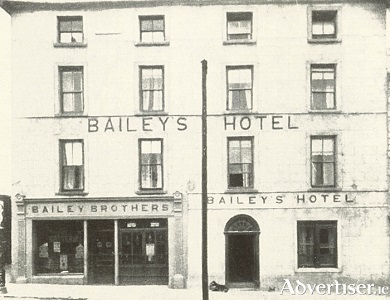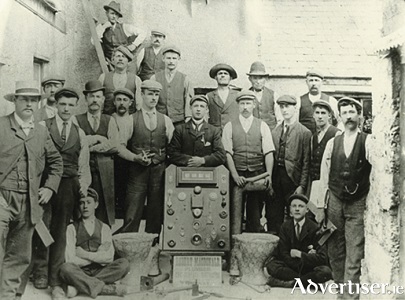Old Galway
Bailey's Hotel (Eyre Square)

When Bailey’s Hotel was being sold it was advertised as being “Fifty Yards from the Railway Station. One hundred and fifty yards from the docks. Frontage; Fifty Feet. Depth: one hundred feet. Eigheen bedrooms,four reception rooms. One additional large room sixty feet by twenty six feet. Bath rooms, lavatories, Kitchen, Pantry, Yard etc. Electric light throughout. Very fine bar, seven day licence. Premises held under lease of 99 years from March 1904, at yearly rent of £4.”
Robert MacDonald, Sanitary and Heating Engineer

This photograph was taken in 1900 of the staff of Robert MacDonald, the plumber from Dominick Street. The business was started by his father, Peter MacDonald (late manager for Ross and Murray), who advertised himself in 1887 as “Plumber, Brassfounder and Gasfitter”.
The first Galway-London airmail flight

On August 26th, 1929, a North German Lloyd Liner arrived at 6.30am in the morning in Galway Bay from New York. Special bags of mail were immediately taken from the ship into Galway by launch, and together with mails that were especially made up in Galway Post Office, were rushed by car to Oranmore Airport. Notices has been placed in the Eglinton Street Office saying that letters would have a special impress affixed for this flight, and that they should be posted early.
Christmas QUIZ 2016

Tom Kenny's Old Galway contribution was in the form of the annual picture quiz, which accompanied Dick Byrne's (devilish) crossword.
The Magic of Glynn's

It was Leonard Martin’s idea to bring Santa Claus to Galway for the first time when he introduced him to his shop in Mainguard Street. It was such a novelty that the mayor, Joe Costelloe came formally to the shop to welcome Santa and shake his hand. Leonard Martin’s shop (where St. Anthony’s Credit Union is today) opened in 1941. For most of the year it was largely a hardware shop by at Christmas it became a toyshop exclusively. The man who played Santa Claus was a war veteran named Jack Kerr.
Pádraic Ó Conaire and the Rising

Pádraic Ó Conaire was born on February 28th, 1882 in a pub by the docks, to middle-class Catholic publicans. He briefly attended the Presentation National School but when his parents both died young, he went to live with some of his extended family in Rosmuc. He later went to school in Rockwell and from there to Blackrock College in Dublin. He emigrated to London and took a lowly job in the Civil Service. He joined the local branch of Connradh na Gaeilge and flourished as an Irish language teacher and writer. In 1901 he published his first short story, An t-Iascaire agus an File.
Lindbergh

Out of the mists of the Monday afternoon of October 23rd 1933, there came to Galway a seaplane with a blue black fuselage, orange wings and silver floats. She circled low over the Claddagh, swooped across the old Spanish Arch, and taking a wide sweep over Lough Corrib, swung around and landed near the light-house at 65 miles an hour with scarcely a ripple on the water. Claddagh boats put out in welcome for it was Colonel Charles A. Lindbergh who had flown alone from New York to Paris in May 1927, in 33.5 hours. He had come to Galway as a technical adviser of Pan-American Airways to see what facilities Galway Harbour had to offer as a seaplane base. The Claddagh boatmen towed his plane into New Docks where he was met by several local dignitaries.
The Fishmarket, 1908

“The Younger Women with their cloaks draped around their heads looked piquant enough, their faces had not unfrequently the sweetest expression of passion, and their lips pouted charmingly. The old fisher-wives, on the other hand, who sat near the casks and smoked damp tobacco in short clay pipes, had something witchlike and menacing about them”.
So wrote Julius Rodenberg in 1860. He obviously had a thing for beautiful young Galway women as he also wrote about them elsewhere. As for the older women, I would say they just glared at him because he did not buy any fish. Otherwise, what he wrote could be true of our 1908 photograph.
.png)